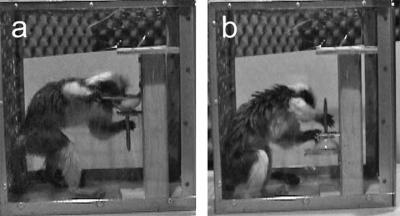Waiters will pick up an inverted glass with their thumb pointing down if they plan to pour water into the glass. Grabbing thumb-down may feel awkward at first but it allows the waiter to be more comfortable when the glass is turned over and water poured inside.
The way human adults grasp objects is typically influenced more by their knowledge of what they intend to do with the objects than the objects' immediate appearance. We perform these tasks, and even tasks like grabbing a pencil, without thinking, but the motor planning necessary to grasp an object is quite complex.
Psychologists call this the “end-state comfort effect,” when we adopt initially unusual, and perhaps uncomfortable, postures to make it easier to actually use an object.

Does this occur because motor planning abilities were crucial in facilitating the evolution of complex tool use in humans? If so, then is this something that other animals, non-tool users, would also try to do.
Pennsylvania State University psychologists, Dan Weiss, Jason Wark, and David Rosenbaum decided to see if cotton-top tamarins (non-tool users) would show the end-state comfort effect. In the first experiment, Weiss and colleagues presented the monkeys with a small cup containing a marshmallow. The cup was either suspended upright or upside down. Would these monkeys, a non-tool using species, adopt an unusual grasping pattern while removing the cup from the apparatus to retrieve the marshmallow?
The results in the December issue of Psychological Science are fascinating. The monkeys grabbed the inverted cup with their thumb pointing down, thereby behaving much like human adults. In the second experiment, the monkeys were confronted with a new handle shape and still displayed grasps that were consistent with end-state comfort.
This research is the first to provide evidence for more sophisticated motor planning than has previously been attributed to a nonhuman species. The authors suggest that formulating relatively long-term motor plans is a necessary but not sufficient condition for tool use.
“Our results may be taken to suggest that the reason tamarins don’t use tools in the wild is not that they lack the ability to plan ahead, but rather that the scope of their planning is limited,” say the researchers.






Comments